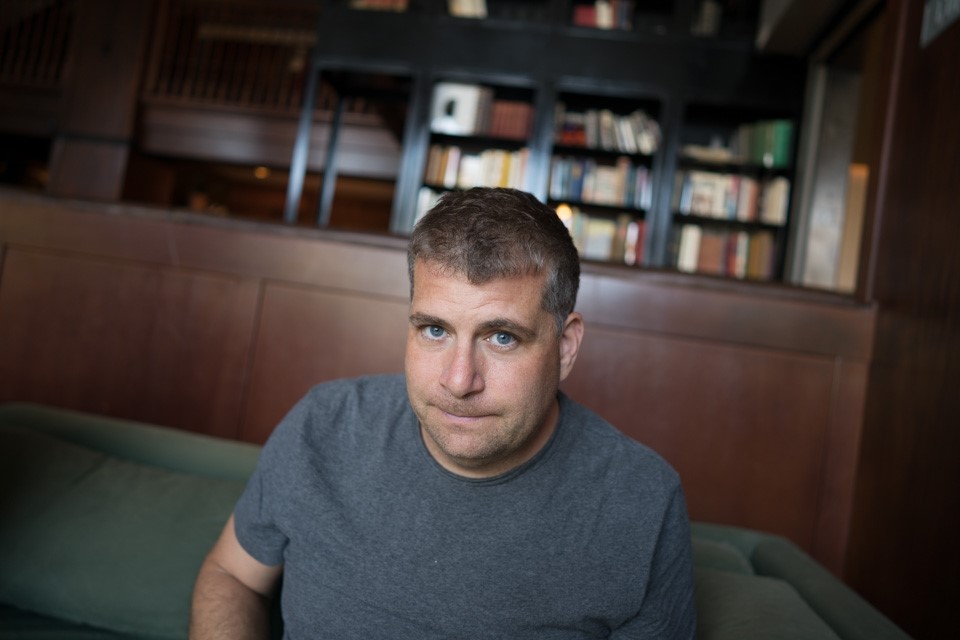Sony RX100 III vs. Canon G1 X Mark II: Camera Shootout
Two hot compact cameras aimed at serious photographers battle it out for image and video quality. Find out which is best for you.
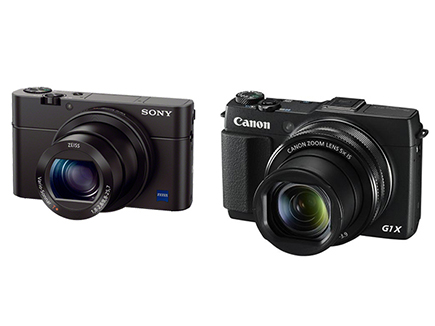
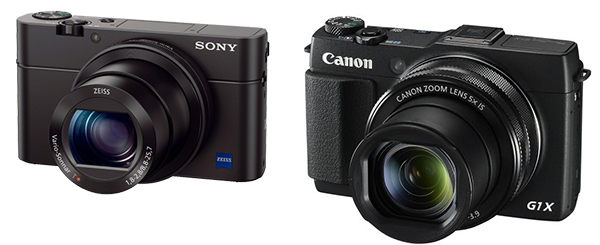
As cellphones chew away at the point-and-shoot market, camera makers have begun to offer compacts with enthusiast-level capabilities. The two hottest model lines in this category have seen major upgrades recently: the Canon G1 X Mark II and Sony RX100 III (each listing for $800). While they have different design sensibilities, both cameras are aimed at the same type of photographer—the shooter looking to get as close as possible to mirrorless or DSLR quality images and video in a compact body. We put these two cameras to the test to see which one is truly the best choice for the image-conscious shooter with a need for portability.
Camera features: strengths and weaknesses
The 21-megapixel Sony RX100 III features a 2.9X zoom lens covering the full-frame camera equivalent of 24-70mm, with a large maximum aperture range of f/1.8 (wide end) to 2.8 (telephoto). This gives the camera the ability to shoot at lower ISO light sensitivity (meaning less graininess) even in relatively dim conditions.
(If you get stuck on any of this terminology, please see our Digital Camera Glossary.)
The 13-MP Canon G1 X Mark II offers a longer, 5X zoom range equivalent to 24-120mm. It has a maximum aperture of f/2.0 on the wide end (almost the same as the Sony) but ratchets down to f/3.9 when at maximum zoom. The Sony's zoom stops at 70mm, but at that length the Canon lens is already at f/3.5, meaning that Canon loses almost an f-stop (i.e., the sensor receives almost 50 percent less light) at 70mm. (Enable your browser's ad or popup blocker if ads are obscuring the bottom of the photos below.)

The rear of the Sony features a bright, clear, articulating 3-inch LCD display (non- touch screen). On top is a clever, retractable OLED electronic viewfinder — something nearly unheard of in this class of camera. However, adding the EVF forced Sony to remove the hot shoe for attaching a more powerful flash.
In updating the G1 X to the Mark II, Canon added touch-screen capability to the rear 3-inch LCD. But instead of swinging out to the side and rotating, the screen now simply tilts up and down — as the Sony's LCD does. Canon has also ditched the optical viewfinder that was on the G1 X. That's fine, since it didn't provide a through-the-lens view and wasn't helpful in framing shots. Canon does retain its accessory shoe for external flashes as well as for a $300 tiltable LCD electronic viewfinder, though that's a steep price for an add-on.
Winner: Draw
These two cameras are closely matched in capabilities, and each has its strengths.
Camera design: size discrepancy
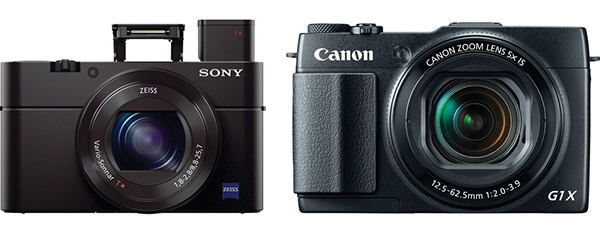
The RX100 III is surprisingly light and compact. Weighing just over 10 ounces and measuring 4 inches wide, 2.2 inches tall and 1.6 inches deep, it slides into a pants pocket. Despite that, the camera offers a full complement of controls. A front dial around the retractable lens can be programmed to adjust various settings, such as aperture, shutter speed or ISO. Several other controls are also programmable.
The G1 X Mark II is nearly twice the weight of the RX100 III, half an inch taller and wider, and a full inch deeper. Squeezing into a pocket is out of the question. However, the thicker design incorporates not only a longer lens mechanism but also two rotating dials around the base of the lens for changing camera settings, such as Aperture and Shutter. As with the Sony, this allows for control of key features from the front of the body, without having to dig into an on-screen menu.
Winner: Sony RX 100 III
This camera provides almost all the options of the Canon G1 X in a much smaller, more portable package. The shorter zoom is the only significant sacrifice.
Bright Light Image Quality
We shot with the Sony RX 100 III and the Canon G1 X MII in a variety of lighting conditions from bright sunlight to nighttime. Both cameras were strong performers overall, but both also exhibited some typical image quality issues.
MORE: How Many Megapixels Do you Really Need?
Many of our shoots were of outside scenes with a mix of bright sunlight and deep shade, a challenging situation for all cameras. The Canon's much-larger 1.5-inch sensor should have handled these situations better, but Sony is using a newer 1-inch sensor, and the RX100 III regularly came out on top.
Exposure: over and under
While the Canon G1 X MII was better with shadow detail, it overexposed many light parts of photos, including almost every cloud in almost every outdoor shot. The Sony RX 100 III handled these and other highlights much better, although it tended to underexpose shadows. In the following photos, you can clearly see how the Canon has overexposed the white base of the statue, while the Sony photo has more even exposure.
(Click on any of the following photos to display larger versions.)


Winner: Sony RX 100 III
The Sony excelled at capturing the highlights that people tend to notice most. And while photo-editing apps can easily brighten dark images, overexposed shots are harder to rescue.
Color: warm and cold
When shooting portraits, the Canon delivered images that tended toward warmer colors, while the Sony created cooler images. Neither produced truly accurate skin tones, but the warm Canon images are closer to accurate and more pleasing.
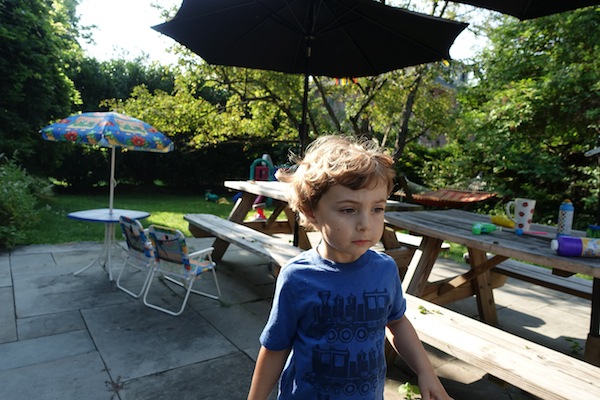
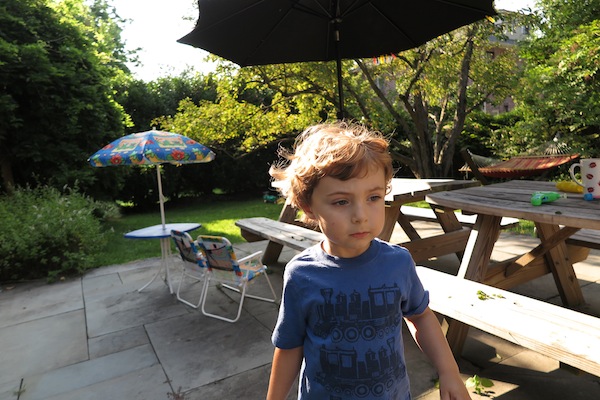
Winner: Canon G 1X MK II
Canon's images tended to be a bit warmer than the Sony's, which makes for a more pleasing picture.
These impressions jibe with our lab test results, in which we used the Imatest analysis software to evaluate photos of test patterns taken with each camera. The Delta E reading, an overall measure of color accuracy, showed the Canon slightly edging out the Sony, 11.26 vs. 12.97 — on a scale in which 1 is perfect. Both models scored far better than that average of 18.87 for all cameras we have tested.
MORE: Best Budget Photo Editing Software
Image Detail: exposure matters
Both cameras show detail well, but the Sony triumphs. First, it simply has more pixels to capture fine features, as in the close-up of a flower below. Second, its signature darker exposure better preserves details, such as the texture of the pink flower, which are blown out in the Canon photographs. Both photos were shot using pattern metering, which considers the whole frame equally. When we switched to center-weighted metering, the Canon still produced a too-bright exposure of the flower.


Winner: Sony RX 100 III
Both cameras create fine images, but the higher resolution sensor and more conservative exposure give the Sony an edge.
Indoor and low-light quality
Both the Canon G1 X Mark II and the Sony RX100 III perform much more consistently when shooting goes indoors in even lighting. Image noise (graininess) goes up at higher ISO light-sensitivity settings, as is to be expected. But in a consistently lit indoor scene, these cameras capture very nice skin tones and excellent detail.
MORE: Best Mirrorless Cameras
Under consistent indoor lighting, both compacts produce high-quality images at ISO settings up to 2000. That said, the Canon has a wider dynamic range (level of detail from very bright to very dark), with better shadow detail, as seen in our test photos of a bookshelf. (The Sony's warm colors are arguably more pleasing, however.) Either camera would be a good choice for a shooter looking to capture real-life scenes without flash (birthdays, family life, etc.), but as the ISO rises, the Canon increasingly has the edge.

Winner: Canon G1 X Mark II
Canon's superior dynamic range provides photos at moderately high ISO levels with less noise and more detail.
Very high ISO
As the ISO settings climb, the Canon G1 X Mark II starts to outpace the Sony RX100 III. At ISO 1000, the images from the Canon are slightly sharper and have better tonality. By ISO 6400, the Sony images are getting grainy and blurry, while the Canon's shots retain much more detail, as you can see in this close-up of the arch in New York's Washington Square Park by night.
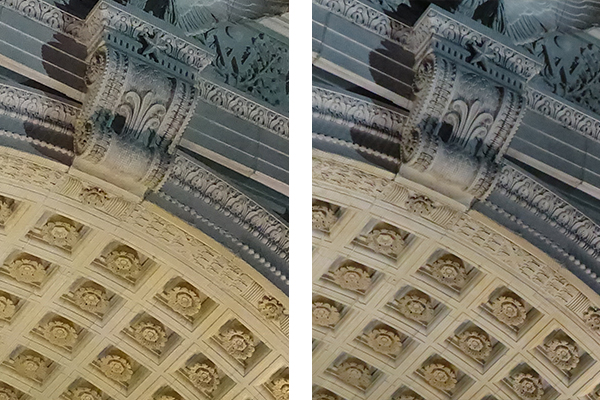
At ISO 12,800, image quality is understandably poor for both cameras, but the Sony images are painfully fuzzy, while the Canon's still have discernable detail.
Winner: Canon G1 X Mark II
The larger sensor in the Canon starts to shine at very high ISO ranges.
Fill flash
Neither camera's strobe can illuminate much at a distance. So the primary use is for fill flash to brighten a portion of a scene, such as a face in a shadow. The pop-up flash on both the Sony RX 100 III and the Canon G1 X Mark II look like they came from the same parts bin.
The Canon flash, over the left edge of the camera, seemed particularly adept at balancing out skin tones in a subject. That said, the camera consistently over-warmed a subject with fill flash, providing a slight orange cast. The Canon fill flash also tended to wash out detail.
Centered over the lens, the Sony fill flash provided very nice illumination for macros. And its light was much more even and balanced, especially with portraits.
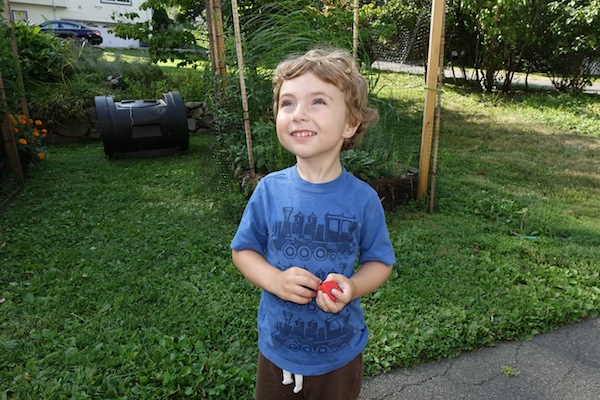

Winner: Sony RX 100 III
The Sony flash created much more balanced tonality.
Video quality
Sony has put an impressive array of video functions in the RX100 III. The camera reads the whole frame 60 times per second. Most cameras skip every other line and only sample 30 times per second. Skipping lines helps reduce the amount of processing required but results in moiré (wavy-line) patterns, while the lower sample rate causes stuttering motion.
MORE: How to Shoot Great Video
The RX100 III can capture video in XAVC S format, a standard that keeps much of the original video data intact. The Sony captured more detail than the Canon, producing almost no discernable jagged edges or moiré, whereas the Canon had plenty.
Bright light video: focus is key
The RX100 III is also far more competent at picking a subject and maintaining focus, whereas the GX 1 MII kept hunting, as in this clip of musicians in a park. This video exhibits another glitch. By default, the Canon's Wind Filter is set to Auto. (The Sony's default setting is Off.) The Canon mistakes the sound of a drum for wind noise, causing it to muffle most of this clip. Listen for the moments when the drumming dies down and the singer's voice briefly breaks through.
(As always, compressing video for online viewing, as well as bandwidth issues, can affect playback quality.)
In these clips of a piano player and singer (no drummer), the Canon captures audio at about the same volume as the Sony. (Audio is also fine if you set the Wind Filter to Off.) The Canon also captures a lot of moiré, as in the leaves and the woman's dress in the background. For this segment we tried the Sony's movie-style 24fps setting. We wouldn't recommend it in all settings, as the slower frame rate can lead to a choppy appearance when panning across a scene.
Night video: surprisingly good
Both cameras did surprisingly well in a nighttime torture test — a performance of A Midsummer Night's Dream lit only by flashlights. (The Canon's better low-light capability seems to have closed the performance gap in night video.) The Sony, shooting at 24fps, and the Canon, at 30fps, were able to maintain focus on the character in the center (Titania) as others dance around her. Both cameras quickly readjust exposure as the light shifts. But yet another drum muffles much of the Canon's audio.
Winner: Sony RX100 III
Overall, video quality from the Sony is in a different class than that of the Canon G1 X Mark II.
Autofocus and speed
To test out the autofocus capabilities of both the Sony and the Canon, we used the most challenging subjects—children. In one test, we followed a the author's sun around as he climbed and jumped. In another test, we photographed him running toward us in a series of shots.
Both cameras focus quickly and accurately, though the Sony has better face detection. For instance, the RX100 III was able to lock onto profiles and three-quarter views more consistently than the Canon G1 X Mark II could.

The Sony proved more capable of locking onto a target, and was particularly good at tracking a child running toward the camera, losing focus only as the subject passed extremely close to the lens (but still within its focal range). The Canon lost focus much farther out.
Neither camera was particularly good at focusing on erratically moving subjects. That's to be expected from their contrast-detection focusing systems, which are not as adept as the phase-detection AF technology in DSLRs and high-end mirrorless cameras.
MORE: Why Autofocus is the New Megapixel
When capturing images, the Sony seemed much more responsive. There was a noticeable shutter lag with the Canon from frame to frame. The Sony screen didn't "blank out" between frames, as did the Canon, and returned to live view faster.
With exposure and focus locked (i.e., set once at the beginning), the Canon has a maximum burst rate at full-resolution of 5.2 frames per second, while the Sony achieves 10 fps. Both cameras clock in around 3 frames per second when they auto adjust focus and metering for each shot.
Winner: Sony RX 100 III
The Sony felt faster and more responsive to focus and shoot, and it held focus better.
Wireless capabilities
Both the Canon G1 X Mark II and Sony RX100 III offer Wi-Fi for transferring images to a smartphone, as well as NFC connectivity for one-touch pairing with NFC-equipped Android phones.
The connection process is similar for each device. First, download the free app for iPhone or Android: Sony PlayMemories Mobile or Canon Camera Window. Each camera contains a Wi-Fi access point, which you log into from your smartphone's Wi-Fi. This requires selecting the camera's access point with names (SSIDs), such as G1XMARKII-568_Canon0B. They don't roll off the tongue. But you only have to select, not type them by hand. You'll then enter the password the camera displays on its screen.
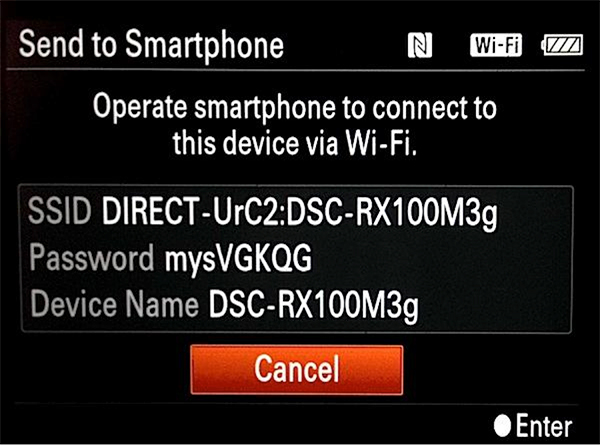
Both cameras have NFC wireless chips. So if you have a recent-model Android phone, you can do a few things by simply tapping devices.
Things didn't go as promised with two iPhones we tried. While we could connect to the Canon's Wi-Fi signal, the Canon Camera Window app failed to display the selection of images on the screen. The Sony app took its time, but did finally display images that could be transferred to the phone — at a choice of full size, 2MB and VGA (640 x 480).
Things didn't go any better with an HTC One Android phone. Despite having NFC, connecting the phone still required the old-school method of entering a password for both cameras. Once the phone was paired with the RX100 III, it was possible to transfer whatever photo was displayed on the camera's screen by tapping the two devices together. The Canon situation was the same with the HTC as with the iPhones. While it was technically possible to connect the phone to the camera's hotspot, the Camera Window app failed to show the thumbnails of photos on the camera to select from.
In short, the Canon was too janky to consider functional, and the Sony was just barely functional. This was a sad showing compared with the Wi-Fi capabilities of Nikon cameras such as the Nikon 1 J4, which connect relatively easy to transfer photos. And it was pathetic compared with the Olympus and especially Samsung cameras (such as the NX30), which allow not only easy photo transfer but also full remote control of the camera from the smartphone.
Winner: Neither
Both manufacturers should rethink their wireless connectivity options and usability.
Overall winner: Sony RX 100 III
The RX 100 III has an amazing array of features and a full complement of manual and automatic shooting modes in a body that's half the weight of the Canon G1 X Mark II and considerably smaller. While the Canon reproduces more accurate skin tones in many instances, the Sony stands out for better exposure and considerably finer video quality.
That said, the Canon has one big thing in its favor — a longer zoom lens. If you need the extra range, the GX 1 M2 is a fine choice. For everyone else, though, the RX 100 III's better lens and video quality, faster autofocus and easier portability give it the edge.
Scorecard
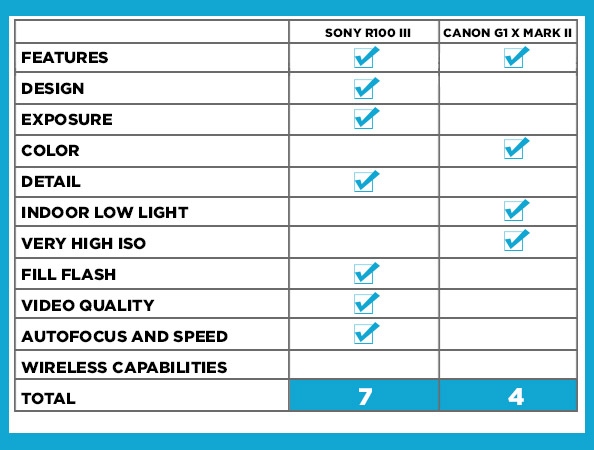
Sign up to get the BEST of Tom's Guide direct to your inbox.
Get instant access to breaking news, the hottest reviews, great deals and helpful tips.
-
massimoIT I possess a RX100 mark I and really is a great camera, but there is one major drawback which is pointed out in this article too (section “Color: warm and cold”).Reply
Auto white balance gives very inaccurate color temperature drifted towards blu in outdoor scenes (seaside and skiing photo are worst cases). I got a spread of approximately 1500K between auto and custom (gray card) white balance.
I really don't like this cold (inaccurate) color and I have to correct white balance any time I take an outdoor picture!!
-
MrTap I have G1XmkII. As Massimo pointed out, the skin tones on RX100 samples seem cold and lifeless untweaked. G1Xm2 has a similar drawback in the opposite direction -- the foliage is too yellowish out of camera, and browns turn to purples (see Plato's book back in 'Indoor and low-light quality' -section sample photo, and how differently Sony and Canon handle it) The brown becoming purple and greens turning yellowish is typical out-of-camra RAW, it gets worse the less light there is.Reply
Seems that with either of these cameras, one will have to correct the white balance on outdoor pictures, as both are way off :(
By the way, thanks for these comparison photos, that better than any other review of studio comparison shots clearly shows what kind of images one can expect in normal shooting. -
jackpro Good review NFC sucks big time on Sony RX100 3 trying to connect to a Samsung Note 4 wifi was fineReply
